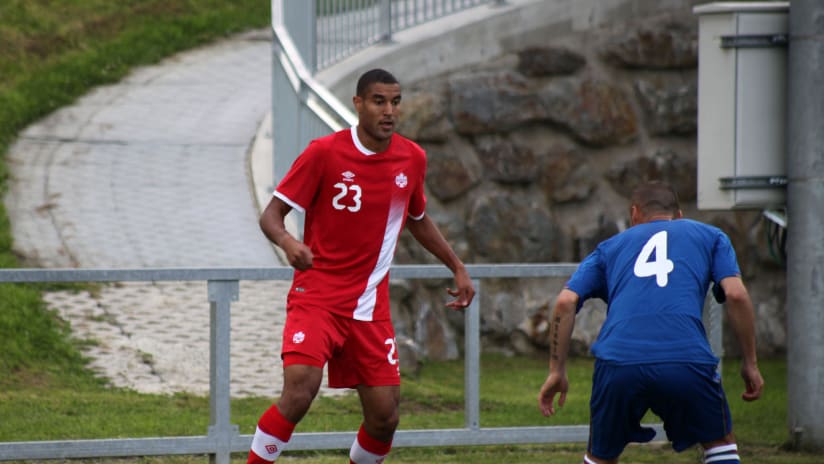There’s nothing left to hide behind, Canadian soccer fans—the next stop is San Pedro Sula, Honduras.
While the diehards scuttle off in cold sweats for a few moments, here's a quick primer for those less attuned to the history of Canada’s men’s team. Following Tuesday’s 2-1 win in a friendly against Uzbekistan, Canada’s next game is a World Cup qualifier in Honduras on Sept. 2.
You may be wondering, “Didn’t Canada have some kind of bad game there a few years ago?” Indeed, Canada’s had numerous bad games down there over the years, the most gruesome of which was an 8-1 shellacking back in 2012 that knocked them out of the last World Cup qualifying cycle.
This time, a visit to Honduras and a return to Vancouver’s BC Place (vs. El Salvador, Sept. 6) will determine the team’s qualification fate. Whatever happens, Canada will learn on Sept. 6 that either they’ve advanced to the Hexagonal round for the first time since 1997, or that their dreams of reaching Russia 2018 are officially done.
So while qualification for the Copa America Centenario eluded their grasp, the team did use this international break for a training camp in Austria (which also included a 1-1 draw with Azerbaijan on Friday) as its final opportunity to prepare for those all-important qualifiers.
And, avert your eyes again, Canadian soccer diehards: Yes, this team could make the Hex.
Most promising for Les Rouges in Austria was the threat they posed in the attack. Sure, Canada’s lack of goal-scoring prowess is a long-running punchline on these shores. But the perfect antidote, it would appear, is an infusion of some fresh blood.
It’s perhaps unsurprising that a midfielder who was recently in the Premier League (Junior Hoilett) and one who’s headed there next season (Scott Arfield) would add some oomph to Canada’s attack. In these friendlies—the first two games in which Hoilett and Arfield have started together—the pair have already begun making the sort of impact for which fans had hoped.
Arfield picked up a pair of assists, while Hoilett’s razzle-dazzle on the left side confounded Uzbek defenders to the point where one of them entirely capitulated and decided to head Hoilett’s cross into his own goal. (That’s the story we’ll go with, anyway.)
Meanwhile, an illness to top striker Cyle Larin (which kept him out of both games) seemed like a cruel blow to Canada’s attacking thrust. But his absence precipitated a lineup shuffle that allowed another former MLS Rookie of the Year, Tesho Akindele, to excel on the right wing alongside Arfield.
“Wait, Canada had three goals in two games, one of which was an own-goal, and you’re talking about the promising attack?”
Yes indeed. This is a team, after all, that had scored but once (butt once?) in its previous five matches, a cross that precipitously fell into the opposing goal after deflecting off the posterior of a tumbling Larin.
Larin’s “butt goal” came against Honduras back in November, a 1-0 win at BC Place. But the soccer gods have never been kind when Canada visits Honduras, so the team can’t rely on similar good fortune in pursuit of a good result in September.
They will rely—based on everything head coach Benito Floro has done to this point—on keeping a tight defensive structure and on grinding things out. It’s a reasonable approach for a team that’s historically struggled to get anything in Central America. A 0-0 result in Panama in late 2014 was Canada’s first point in the region in a decade; the team then repeated the feat in El Salvador last November.
And to be clear, a goalless draw in San Pedro Sula on Sept. 2 would suit Canadians just fine—aside from the fans’ demolished fingernails and self-inflicted scalp wounds. However, the team’s World Cup fate simply can’t be left to grinding things out in a Central American cauldron. There must be a Plan B.
Based on these two friendlies, Plan B is simple: Be a team that can score.
While Hoilett, Arfield, and Akindele looked dangerous in Austria, the re-insertion of Atiba Hutchinson, Will Johnson, and a healthy Larin into the lineup gives you a front six that would give pause to any team in CONCACAF.
The question now becomes, where will Floro’s loyalties lie? Will he remain devoted to the likes of 35-year-old Julian de Guzman and Canada’s happy warrior, Tosaint Ricketts? Knowing that his entire tenure as manager rests on the results of the next two games, will he adhere to the system he’s been meticulously preparing for the past three years?
Or will he decide to go into San Pedro Sula with all guns blazing, determined to eradicate Canada’s ugly history with a resounding result for the ages?
Sorry, folks, all you can do for the next three months is wait and wonder about what those answers might be.













